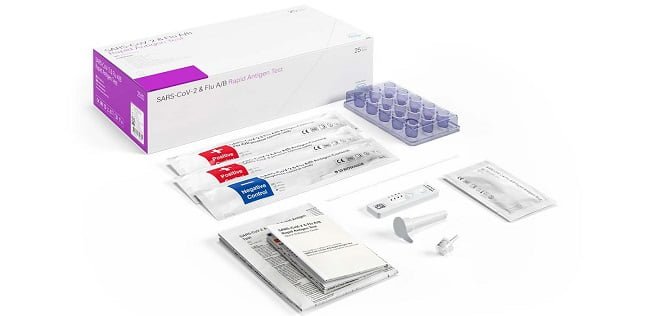As the cool breezes of autumn signal the approach of flu season, the importance of flu testing kits becomes ever more apparent. These kits are pivotal in the timely diagnosis and management of influenza, helping to curb the spread of the virus and ensuring that individuals receive the appropriate treatment. The development and widespread availability of flu testing kits have revolutionized the way we approach and manage this common yet potentially dangerous illness.
Understanding Influenza
Influenza, commonly known as the flu, is a highly contagious respiratory illness caused by influenza viruses. It can lead to mild to severe illness and, in some cases, can result in hospitalization or death. Symptoms of the flu include fever, cough, sore throat, runny or stuffy nose, body aches, headaches, chills, and fatigue. The virus spreads mainly through droplets made when people with flu cough, sneeze, or talk.
Early and accurate diagnosis is crucial. This is where flu testing kits come into play, offering a convenient and efficient method to detect the virus. The ability to quickly identify whether symptoms are due to influenza or another respiratory pathogen can significantly impact treatment decisions and public health measures.
For those looking for reliable flu testing kits, flu testing kit offered by Cost Plus Med Tech are a trusted option. These kits provide accurate and timely results, which are essential in managing flu outbreaks.
Types of Flu Testing Kits
Flu testing kits come in various formats, each with its own set of advantages and limitations. The most common types include:
- Rapid Influenza Diagnostic Tests (RIDTs): These are the most widely used flu tests. RIDTs can provide results in 10-15 minutes and are relatively simple to perform. They work by detecting antigens (substances that trigger an immune response) from the influenza virus in respiratory specimens. While they offer quick results, their sensitivity can vary, meaning false negatives are possible.
- Direct Fluorescent Antibody (DFA) Tests: DFA tests are more accurate than RIDTs and involve staining respiratory specimens with fluorescent dyes that bind to influenza antigens. These tests are typically performed in a laboratory and can take a few hours to yield results.
- Reverse Transcriptase Polymerase Chain Reaction (RT-PCR) Tests: RT-PCR tests are considered the gold standard for flu testing. They detect the genetic material of the influenza virus with high sensitivity and specificity. While they are more complex and time-consuming, taking several hours to complete, they provide the most reliable results.
- Viral Culture: This method involves growing the influenza virus in a cell culture. It is highly accurate but can take several days to produce results. Due to the time required, viral culture is not typically used for initial diagnosis but may be employed for research purposes or confirming other test results.
How Flu Testing Kits Work
The mechanics of flu testing kits vary depending on the type, but the general process involves collecting a respiratory specimen, such as a nasal or throat swab, and analyzing it for the presence of influenza virus components.
- Sample Collection: Proper sample collection is critical for accurate results. The specimen is usually obtained using a swab that is inserted into the nose or throat to collect mucus and cells.
- Analysis: Depending on the type of test, the sample is then processed to detect the presence of influenza antigens, genetic material, or live virus.
- Results: Results are interpreted based on the presence or absence of viral components. Rapid tests provide results in minutes, while more complex tests like RT-PCR can take several hours.
The Role of Flu Testing Kits in Public Health
Flu testing kits are invaluable tools in the realm of public health. They play a crucial role in:
- Early Detection and Treatment: Rapid identification of influenza allows for timely antiviral treatment, which can reduce the severity and duration of symptoms. Early treatment is particularly important for high-risk groups, such as young children, elderly individuals, and those with chronic health conditions.
- Infection Control: Accurate flu diagnosis helps in implementing infection control measures, such as isolating infected individuals and preventing the spread of the virus in healthcare settings, schools, and communities.
- Surveillance and Monitoring: Flu testing kits contribute to surveillance programs that monitor the spread of influenza. Data collected from these tests help public health authorities track flu activity, identify outbreaks, and make informed decisions about vaccination and other preventive measures.
- Reducing the Burden on Healthcare Systems: By distinguishing influenza from other respiratory illnesses, flu testing kits help prevent unnecessary use of antibiotics and reduce the burden on healthcare systems, particularly during peak flu season.
Accessibility and Affordability
One of the key factors in the effectiveness of flu testing kits is their accessibility and affordability. Making these kits widely available ensures that more individuals can benefit from early and accurate diagnosis.
Cost Plus Med Tech offers a range of flu testing kits designed to meet different needs and budgets. Their commitment to providing high-quality, affordable medical products has made them a trusted name in the industry. For more information, visit Cost Plus Med Tech.
Innovations in Flu Testing
The field of flu testing is continually evolving, with new technologies and methodologies being developed to improve accuracy, speed, and convenience. Some of the latest innovations include:
- Point-of-Care Testing: Advances in point-of-care testing allow for flu tests to be performed outside of traditional laboratory settings, such as in clinics, pharmacies, and even at home. These tests provide rapid results and increase accessibility.
- Multiplex Testing: Multiplex tests can simultaneously detect multiple respiratory pathogens, including different strains of influenza and other viruses like RSV and COVID-19. This comprehensive approach helps in differential diagnosis and appropriate treatment.
- Digital and Connected Devices: The integration of digital technology with flu testing kits has led to the development of connected devices that can transmit test results to healthcare providers in real-time. This facilitates remote monitoring and timely intervention.
- Improved Sensitivity and Specificity: Ongoing research aims to enhance the sensitivity and specificity of flu tests, reducing the likelihood of false negatives and false positives. This ensures more reliable results and better patient outcomes.
Conclusion
Flu testing kits are indispensable tools in the fight against influenza. They enable early detection, guide treatment decisions, and play a critical role in public health surveillance and infection control. The advancements in flu testing technology continue to improve the accuracy, speed, and accessibility of these kits, making them more effective in managing flu outbreaks and reducing the burden of the disease.
As we navigate through flu season, having access to reliable flu testing kits, such as those provided by Cost Plus Med Tech, ensures that we are better prepared to protect ourselves and our communities from the impact of influenza. By staying informed and utilizing these valuable tools, we can contribute to a healthier and more resilient society.



